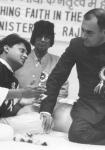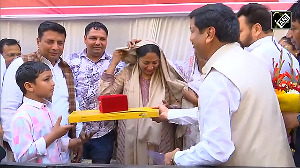Mobile phones, India's largest growing segment is the new battleground for advertisers and marketing wizards always on the lookout for innovative means to shore up their sales chart.
Both GSM (cellular) and CDMA (Wireless in Local Loop) mobile phones are becoming the new tools for advertisers who want to deliver targeted services and sops to customers.
"Unlike the world of personal computers, the mobile world is very exciting. It is not dull or dry but has a lot of action happening right now," says Vijay Mukhi, who heads the mobile services committee of the Indian Merchants Chambers.
Cell phone usage in India has been growing rapidly. India has around 14 million mobile users and the base is growing at a million a month. Estimates predict mobile penetration to stand at 20 million by the end of the year, which would be much greater than the number of Internet users in the country and could soon reach a point where it will surpass the number of landline phones.
So, are mobile phones the next 'killer app' for marketers?
Yes, say cellphone operators, but with a note of caution.
"The mobile phone area right now is like what email and Internet was in the early days. Operators have to be careful to ensure that their databases are not exploited to the extent that they ultimately end up losing value," says Balu Nayar, assistant vice-president, value-added services, Hutch.
The new marketing buzzwords now are 'location based services, 'opt-in advertising', and m-commerce.
For advertisers, mobile phones offer a well-segmented audience. Service providers have databases that clearly provide the demographic details of their user base. Couple this with the location pinpoint and a very potent marketing tool is out there.
In the last two weeks, BPL customers in Mumbai are seeing a new message on their screens. Along with the name of the service provider, cell phones are displaying the exact location where the subscriber is present at that moment.
For advertisers this means that they can send discounts on restaurants or shopping only in places that are close by.
"Cell phone is an interactive, high impact medium that offers personal contact with consumers. It can be very obtrusive but it offers an extremely effective way to get close to the consumer," says Hutch's Nayar.
Short Messaging Service or SMS is the hot new marketing tool. SMS can add value when marketers want to improve the brand experience for customers. It is a very powerful tool as it puts the brand right into the hands of the consumer.
According to an IDC survey in 6 countries in the Asia Pacific region --- Australia, China, Hong Kong, Korea, Singapore and Taiwan --- 80 per cent of the respondents said they are open to receiving SMS ads.
In India, media houses have taken the lead in exploiting SMS successfully.
Indiatimes' 8888 number that offers a host of SMS services gets nearly a million messages a day.
When STAR TV re-launched Kaun Banega Crorepati, after a season's break, it ran a contest where viewers could answer a question by SMS. On the first day of the contest itself, STAR got over 450,000 messages.
Other television channels too are successfully running promotions via SMS. Recently, Aaj Tak had a World Cup Soccer promotion that got 14 lakh (1.4 million) messages from viewers over 18 days.
Television, which gathers much of the advertisers' attention today, is, packed with contradictions. There are 70 million television homes giving a viewership of close to 400 million individuals.
But with the over 100 channels that are available today, advertisers are forced to adopt the 'scatter-gun' approach, which reduces the efficacy in reaching the target audience that they want.
The high rate of ad insertions is also turning away many advertisers. Currently, the average cost of insertion is estimated at Rs 2000/sec.
The specter of conditional access system is also looming large for advertisers. "Nobody can today predict with absolute certainty how CAS will impact the television market but it could very well reduce potential audience numbers," says Shailesh Haribhakti, president, IMC.
All of this only serves to make the mobile phone an increasingly attractive marketing medium.
Internationally, major names such as Disney, Sony Corporation, Sega, BMG and Viacom are now actively involved in 'marketing' the mobile space as well as licensing brands, titles and artistes.
In India, however, music companies are yet to get into offering ring tones for latest releases, though ring tones are one of the hottest properties in the mobile medium.
Already, many attempts have been made to scratch the mobile service pie.
News, daily horoscopes, sports scores, stock quotes and jokes are being offered by almost every major news organisation via SMS. All customers have to do is send an SMS to the number and they will get the information they want.
The revenues gathered from providing this service is being split between the cell phone operator and the content provider.
It is not just the media houses or private companies that are opting to market their services through mobile phones.
Indian Railways, for instance, offers a service that lets users check if their tickets are confirmed by sending an SMS along with their PNR number. In Bangalore, state board exam results are already being offered on SMS.
Indian Airlines offers flight alerts through cell phones, while most other domestic airlines offer check-in services through SMS.
Operators like Hutch and BPL are offering movie trailers along with services like flirting and Net access.
In case of CDMA phones like Reliance, mobile ad banners are being pushed.
"Mobile banner ads are shown to be 10-50 times more efficient than Net banner ads. In case of R-world if you see there is no way a customer can miss the banner ads on their phones," says S P Shukla, president, Reliance Infocomm.
For cell phone operators since the revenues are shared between the content providers and the operators, a successful take off of these services means an increase in their kitty.
"India has the lowest cell phone tariff in the world. This also means that the average revenue per user has come down significantly since the service was started. But there remains a high demand for information and services on the cell phone so it can become a new area to tap into for revenues," says Sanjoy Mohanty, chief officer (marketing and customer care), Escotel.
Industry experts feel that the growth in marketing services can come from areas like banking, video, audio clips and even email services.
But before that a few barriers to realising the potential of mobile marketing need to be cleared.
There is a very real chance that marketers will kill the golden goose. Like email, which started off as a great marketing opportunity was finally submerged by a deluge of spam that killed the medium for legitimate advertisers.
Privacy can become another issue. There's also the challenge on marketers to come up with ideas that can best exploit SMS.
"Consumers will soon get worried about privacy and raise issues about protection of their privacy when advertisers start targeting them location wise.
"Also agencies and marketing people need to look at mobiles as a new medium and devise new strategies that explore it.
"Clearly, mobile cannot be a standalone medium as it can't deliver a robust and complete message.
"So the integration with other mediums like television, Internet or print has to be done," says Andre Nair, CEO, Mindshare, a media-buying house.





 © 2025
© 2025